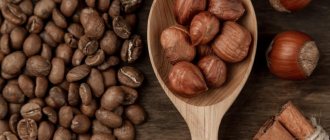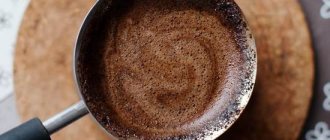Choosing an Armenian Turk
Copper Turks are made by hand by masters, despite technological progress and improvements in tableware production methods. They are suitable for brewing Armenian coffee. Only real copper is selected for manufacturing, and the inside is coated with food-grade tin. In some workshops you can find brass Turks, which use only food-grade alloy that does not contain lead.
The dishes have two layers: a base 1-2 mm thick and a top coating with decorative elements. Turks are a one-piece construction with no seams. This is done so that the copper does not oxidize and the seams do not come apart.
Armenian Turks are distinguished by their unique decor, which generously decorates the walls of their dishes: embossing, forged elements or engraving. Copper cezves are a special work of art. On them you can see realistic patterns of flowers and plants, as well as entire scenes of military battles.
Traditional cezves are safe for health and can last a very long time. They are distinguished by a unique design and have a very affordable price. In addition, copper is better than other materials in emphasizing the special taste of coffee and preserving the aroma.
How to prepare a burning drink in Armenian?
Men will especially like this coffee because of the special effect when serving it. It is easy to prepare and can even be done at home.
Ingredients:
- water - 195 ml;
- coffee powder - 25-35 g;
- sugar;
- rum - 35 ml
Preparation:
- Pour coffee, granulated sugar into the cezve, and pour clean water from the source.
- Place on the stove and brew like espresso.
- Then let the drink sit for three minutes, pour it into cups.
- Pour the Rum into a large stainless steel spoon and set it on fire.
- Carefully pour into cups.
Treat your guests to this coffee right away so that the rum does not have time to go out in the cups.
The same burning effect can be achieved by adding burning alcohol, vodka or cognac to coffee.
How to brew Armenian coffee in a Turk
At first glance, it seems that there is nothing special in the recipe for making Armenian coffee. As usual, use 1-2 teaspoons of coffee in half a glass of water. At the same time, sugar is added, which also does not contradict Armenian traditions.
However, there are certain nuances of how to brew coffee in Armenian. First of all, you should never rush to stir the coffee powder before it gets wet and sinks in the water. Only after it is completely wet can you start stirring. According to the traditional recipe, coffee can be stirred once.
After the temperature of the water in the Turk reaches 90°, you need to remove the foam from the surface and carefully place it on the bottom of the coffee cup. The temperature can be determined by the presence of bubbles and the rise of foam. It is laid out among all the cups, and then the Turk is put back on the fire and continues to cook.
Then wait for the foam to form again and remove from the stove. It is very important not to bring the drink to a boil during preparation. Now you can pour the remaining coffee into cups. This way it is better to cook two servings at once. The taste will be rich, and the coffee foam will be perfect.
What is the situation with coffee in Armenia itself?
It is difficult to find another country where they love coffee as unconditionally and devotedly as in Armenia. Moreover, the Armenians turned the use of this luxurious drink into a real cult. The fact that coffee trees do not grow on Armenian soil does not in the least affect the popularity of the drink among local residents. Imported in ancient times from neighboring Turkey, coffee has firmly entered the life of Armenians, becoming a truly national drink.
Moreover, this is not only a “morning” drink, coffee is drunk around the clock - at home, at work, and away. Often people meet not so much to communicate as to drink coffee together. According to research, the average Armenian drinks almost 70 liters of the aromatic drink per year. Instant coffee is not recognized in Armenia - only freshly ground and freshly brewed.
Almost all over the world the name of the drink sounds the same - coffee. But the Armenians have a special word - surch. It is not known for certain where it came from. According to one version, the word arose from the merger of two Armenian words - “black” and “water”. According to this logic, Armenian coffee is “black water”. Another version claims that surch is nothing more than an onomatopoeia that imitates sipping coffee from a cup. The truth is no longer known, but Armenians continue to enjoy surch.
Types of coffee sold in stores
Armenian coffee in stores can be found in different packaging: in a plastic or metal can, in a food-grade plastic bag or in paper packaging. It is sold in grains or ground.
Armenian coffee beans
- Arabista is a medium to deep roast bean sold in 200 gram ziplock bags. It is made from the finest Arabica beans that were harvested in Colombia, Guatemala, Brazil or Costa Rica.
- "Royal Armenia". Sells premium medium-roast coffee beans. There are two varieties of the drink: Arabica and Robusta. The unique aroma is obtained by roasting a mixture of Colombian and Brazilian beans.
Ground Armenian coffee
- "JEZVA CLASSIC". The company delivers selected medium-roasted ground coffee with ultra-fine grinding. The blend includes three Arabica beans based on COLOMBIA SUPREMO. The coffee has a rich and balanced bouquet with nutty and chocolate undertones.
- "MY COFF". Offers ground coffee in paper bags of 100 grams. Finely ground Arabica coffee has a soft, delicate and rich taste. Unlike Robusta, it has a persistent aftertaste and contains low levels of caffeine.
Do you brew coffee in a Turk?
Yes
No
P-i-i-t...
The premonitions came true. It is unusually hot in Armenia in July. And without water you simply cannot survive in a melting city. At every step there are trade stalls with refrigerators in which you can find the entire range of non-alcoholic drinks - from local mineral water and cold coffee and tea to tan (matsun whipped with sparkling water). Drinking fountains installed everywhere help to cope with the heat .
Well, how can we not remember Dilijan water, by the way, one of the most delicious in the world! After all, ancient Dilijan is a famous balneological resort, surrounded by protected forests and mountains (located 150 km from Yerevan). But no offense to Dilijan residents, the water is wonderful throughout Armenia. So we move forward, dashing from fountain to fountain, with the risk of catching, if not heatstroke, then a sore throat.
On the streets of the city you can see yellow barrels of kvass . But small and large barrel mugs have sunk into oblivion, along with fountains for washing them. We tried kvass from a disposable cup - yes... We will drink water.
Secrets of making delicious Armenian aromatic coffee
Despite the fact that coffee does not grow in Armenia, but only undergoes processing, there are traditional recipes in the country. At the same time, a drink made from grains should always be freshly ground.
Classical
The secret of the classic brewing method lies in finely grinding the coffee beans. They are lightly fried beforehand and then literally ground into dust. For the classic recipe you will need:
- ground coffee - 7-14 g;
- sugar - 1 piece of refined sugar or a teaspoon of loose sugar;
- cognac - 3-4 drops;
- water - how much will fit in the cup.
Combine all ingredients in a copper pot and cook over low heat. Without letting the mixture boil, you need to remove the Turk from the stove when foam appears. Pour the finished drink into a coffee cup.
In Yerevan
The peculiarity of the preparation is the very low water content. For Yerevan style coffee you will need:
- finely ground coffee - 1 teaspoon;
- water - approximately 60 ml;
- sugar - you don't have to use it.
Pour coffee into the cezve, add sugar if desired, add water and place on low heat. After heating the mixture, stir it well and continue to cook until foam forms, and then you can remove it from the heat. Before drinking, the cup is heated, coffee foam is placed on the bottom, and the drink is poured on top.
Coffee capital – true or false?
It is quite logical to assume that since there is Armenian coffee, it means that it grows in Armenia. But this is a strong misconception. In fact, the product with this name is Colombian, and Armenia is one of the main cities of the coffee industry in Colombia, whose first settlers were Armenians.
The warm and mild climate of South America is favorable for the cultivation of elite coffee varieties all year round, which is why Armenia is called the “coffee capital” of Colombia.
The town also has a developed tourist destination. This is where one of the coffee museums is located, which both lovers and real connoisseurs of the invigorating drink are eager to visit. It presents varieties of varieties, cooking devices, and history. And if you arrive in the city at the beginning of summer, then you have every chance to get to the National Coffee Festival, which is held every year.
And even though coffee does not grow in Armenia (a state in Transcaucasia), the country has its own coffee traditions and unique cooking recipes.
The Case of the Fish
We go to Lake Sevan, and there is a prince fish - Sevan trout Ishkhan. The closer to Sevan, the more often men come out onto the road, spreading their arms wide in a welcoming gesture. But hospitality has nothing to do with it. These gestures are probably familiar to fishermen, they say, I caught such a fish, and you buy it! If you stop, with a sly wink, they will lead you with them into the roadside bushes, where they allegedly hide the magic prince fish.
In reality, the fairy tale about the goldfish is just a fairy tale. Sad. The real Ishkhan has not been caught in the net for a long time, because it is on the verge of extinction, and catching it is prohibited in Sevan.
Therefore, we only stopped at a coastal restaurant, where we were very happy with the whitefish kebab. In addition to the understandable fish khorovats and khashlama (usually lamb stewed with onions, peppers, tomatoes), I was interested in the unfamiliar dish “Fish Gata”. Chef Tamara explained that their gata is a fish carcass cut along the ridge, spread out, rolled in flour and fried. Well, as one of my Lithuanian chef friends said, the main thing is to intrigue, and then we’ll figure it out. Meanwhile, fishermen appeared with a catch of crayfish. The question immediately followed whether we would like to try the crayfish kebab. It is made from ground crayfish neck meat with herbs. I imagined how many crayfish are needed for one kebab, and I somehow felt sorry for them, so the khorovats and khashlama suited us quite well. And again cheese, herbs, Armenian bread matnakash . As a side dish for khorovats – potato mugs baked on skewers. And of course - “Wow, what wine!” It’s not wine – it’s a living soul! But about it next time, because there are other “soulful” drinks in this warm country.
What to bring
- Let's not be original. Undoubtedly, cognac . There's no need to persuade, is there? To avoid bitter disappointment from counterfeits, it is best to buy it in branded stores or from large distributors. An unexpectedly low price should alert you.
- Dried fruits . Dried apricots, dried peaches, alani beads (dried skinless peaches with nut filling), candied apricots, peaches, pears, cherries and cherries with hazelnut or almond kernels, thin sheets of fruit marshmallow, called here sour lavash - well, is it possible before resist this? Even amazing still lifes made from all this abundance are sold.
- Crafts from pomegranate . These can be vases, boxes, candlesticks, amazing silver jewelry, even keychains or pendants made of dried pomegranate fruits. Pomegranate is revered in Armenia as a symbol of life, abundance, and fertility. Such a talisman is simply necessary in the house.
"Kerusus" - eat and be silent
This is the literal translation of the name of this delicious dish of small, long, thin pieces of lamb, fried in oil and stewed with tomatoes and onions. And definitely lots and lots of greenery!
Cooking traditional Armenian dishes is not easy or quick. Moreover, they will probably sit down at the table with their own people, of whom there are already quite a few, and their own people, and most likely someone else who dropped in for a glimpse. And indeed, you have to really love what you do, and, of course, those for whom you are preparing all this, in order to make three or four hundred pieces of thin dolma ( in our country it is more often called dolma) from minced meat and grape leaves or mold it for everyone microscopic manti , or, say, for hours beating fresh meat with a special stone hammer for kofta - boiled meatballs the size of an orange from meat crushed into puree.
And yet, despite the abundance of dishes from all sections of the cookbook, Armenian cuisine is most often associated with barbecue. In every national restaurant (no matter where it is located - in Armenia itself or beyond its borders) the main dish is shish kebab , or khorovats . In my deep conviction, you cannot find tastier Armenian kebab.











